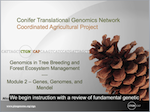Authors:
Nicholas Wheeler, Oregon State University; David Harry, Oregon State University; Heather L. Merk, The Ohio State University
Introduction
This module focuses on linkage disequilibrium or LD. An understanding of LD will pave the way for the introduction of association genetics and genomic selection. LD is at the root of virtually all marker informed breeding applications. Most outcrossing plants, including the vast majority of coniferous and flowering trees, have genomes that are largely in linkage equilibrium at the population level. QTL mapping works because specific crosses create short-lived LD as a function of genetic linkage unspoiled by generations of recombination (crossing over). Strong LD is largely a function of tight linkage. As we shall see, there are other factors at play; alleles in different genes at great distances from one another on a linkage group, or even on different linkage groups, may persist in LD for some time. The study of LD has revealed a great deal about genome organization and evolution.
Module 10 — Linkage Disequilibrium
See other Conifer Genomics Modules
You can also watch the video on YouTube.
References Cited
- Altshuler, D., L. D. Brooks, A. Chakravarti, F. S. Collins, M. J. Daly, P. Donnelly, R. A. Gibbs, et al. 2005. A haplotype map of the human genome. Nature 437: 1299-1320. (Available online at: http://dx.doi.org/10.1038/nature04226) (verified 1 June 2011).
- Bamshad, M., and S. Wooding. 2003. Signatures of natural selection in the human genome. Nature Reviews Genetics 4: 99-111. (Available online at: http://dx.doi.org/10.1038/nrg999) (verified 1 June 2011).
- Cardon, L., and J. Bell. 2001. Association study designs for complex diseases. Nature Reviews Genetics 2: 91-99. (Available online at: http://dx.doi.org/10.1038/35052543) (verified 1 June 2011).
- Christensen, K., and J. C. Murray. 2007. What genome-wide association studies can do for medicine. New England Journal of Medicine 356: 1094-1097. (Available online at: http://dx.doi.org/10.1056/NEJMp068126) (verified 1 June 2011).
- Devlin, B., and N. Risch. 1995. A comparison of linkage disequilibrium measures for fine scale mapping. Genomics 29: 311-322. (Available online at: http://dx.doi.org/10.1006/geno.1995.9003) (verified 1 June 2011).
- Eckert, A. J., J. L. Wegrzyn, B. Pande, K. D. Jermstad, J. M. Lee, J. D. Liechty, B. R. Tearse, K. V. Krutovsky, and D. B. Neale. 2009. Multilocus patterns of nucleotide diversity and divergence reveal positive selection at candidate genes related to cold hardiness in coastal douglas fir (Pseudotsuga menziesii var. menziesii) Genetics 183: 289-298. (Available online at: http://dx.doi.org/10.1534/genetics.109.103895) (verified 1 June 2011).
- Gibson, G., and S. Muse. 2009. A primer of genome science. Sinauer Associates, Sunderland, MA.
- Grattapaglia, D. 2007. Marker–assisted selection in Eucalyptus. p. 251-281. In. E. P. Guimaraes, J. Ruane, B. D. Scherf, A. Sonnino, and J. D. Dargie (ed.) Marker assisted selection: Current status and future perspectives in crops, livestock, forestry and fish. Food and Agriculture Organization of the United Nations (FAO), Rome, Italy.
- Grattapaglia, D. and M. Kirst. 2008. Eucalyptus applied genomics: from gene sequences to breeding tools. New Phytologist 179: 911-929. (Available online at: http://dx.doi.org/10.1111/j.1469-8137.2008.02503.x) (verified 1 June 2011).
- Gupta, P. K., R. Rustgi, and P. L. Kulwal. 2005. Linkage disequilibrium and association studies in higher plants: Present status and future prospects. Plant Molecular Biology 57: 461-485. (Available online at: http://dx.doi.org/10.1007/s11103-005-0257-z) (verified 1 June 2011).
- Mackay, I., and W. Powell. 2007. Methods for linkage disequilibrium mapping in crops. Trends In Plant Science 12: 57-63. (Available online at: http://dx.doi.org/10.1016/j.tplants.2006.12.001) (verified 1 June 2011).
- Neale, D. B., and O. Savolainen. 2004. Association genetics of complex traits in conifers. Trends in Plant Science 9: 325-330. (Available online at: http://dx.doi.org/10.1016/j.tplants.2004.05.006) (verified 1 June 2011).
- Rafalski, A. 2002. Applications of single nucleotide polymorphisms in crop genetics. Current Opinion in Plant Biology 5: 94-100. (Available online at: http://dx.doi.org/10.1016/S1369-5266(02)00240-6) (verified 1 June 2011).
- Stumpf, M.P.H., and G.A.T. McVean. 2003. Estimating recombination rates from population-genetic data. Nature Reviews Genetics 4: 959-968. (Available online at: http://dx.doi.org/10.1038/nrg1227) (verified 1 June 2011).
Cite This Learning Module
- Wheeler, N., and D. Harry. Linkage disequilibrium [Online Learning Module]. Genomics in Tree Breeding and Forest Ecosystem Management, Conifer Translational Genomics Network. eXtension Foundation. Available at: https://plant-breeding-genomics.extension.org/linkage-disequilibrium:-conifer-genomics-module-10/ (verified April 22, 2013).
Author Contributions
- Nicholas Wheeler and David Harry developed the learning module content.
- Heather Merk developed the webpage.
Funding Statement
Support for the Conifer Translational Genomics Network project and the development of the teaching modules hosted here was provided by the USDA/NRI CSREES CAP Award # 2007-55300-18603, the USDA/NIFA AFRI Applied Plant Genomics Coordinated Agricultural Project Award #2009-85606-05680 and the USDA Forest Service. Development of this page was supported in part by the National Institute of Food and Agriculture (NIFA) Solanaceae Coordinated Agricultural Project, agreement 2009-85606-05673, administered by Michigan State University. Any opinions, findings, conclusions, or recommendations expressed in this publication are those of the author(s) and do not necessarily reflect the view of the United States Department of Agriculture.
Attachments:
Linkage_Disequilibrium.pdf (2.08 MB)
PBGworks 1099

